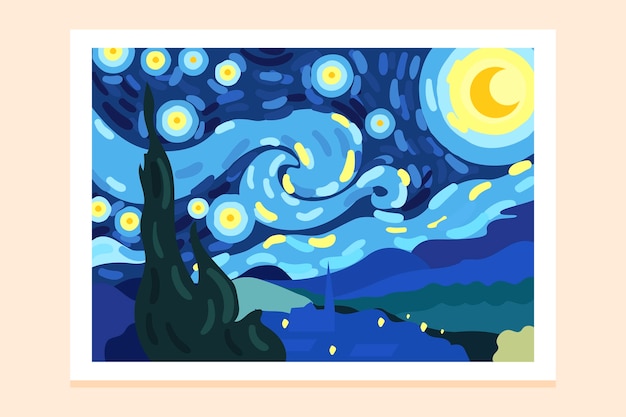Fascinating Facts about Van Gogh

Van Gogh initially wanted to become a pastor like his father but ended up pursuing a career in art instead.
He only sold one painting during his lifetime but are now considered priceless.
Van Gogh’s most famous painting, The Starry Night, was painted while he was in a mental asylum.
He created over 2,100 artworks, including 860 oil paintings.
Van Gogh often used vibrant and contrasting colors to express his emotions.
The artist had a close and troubled relationship with his brother, Theo, who supported him financially and emotionally.
Van Gogh cut off a portion of his left ear after an argument with fellow artist Paul Gauguin.
He was known to send his artwork to friends and family as gifts, often accompanied by heartfelt letters.
Van Gogh was inspired by Japanese woodblock prints, which influenced the composition and style in some of his paintings.
He was a prolific letter-writer, with over 800 surviving letters to Theo and other acquaintances.
Van Gogh was fascinated by sunflowers and painted several series depicting them.
The artist suffered from various mental health issues, including depression and anxiety.
Van Gogh was greatly influenced by the works of Jean-François Millet and Édouard Manet.
He was known to paint rapidly, often completing a canvas in a single sitting.
Van Gogh’s paintings are characterized by dynamic and expressive brushwork.
He spent time in Paris, where he met and interacted with several other famous artists of his time.
Fascinating Facts about Van Gogh part 2
Van Gogh’s art became more widely recognized and appreciated after his death.
The artist’s tragic life story has added to the intrigue and mystique surrounding his artworks.
Van Gogh’s painting, Irises, was sold for a record-breaking price of $53.9 million in 1987.
He lived in poverty for most of his life, relying on the support of his brother and friends.
Van Gogh painted several self-portraits throughout his life, providing insight into his own struggles and self-reflection.
Some of his famous paintings include Sunflowers, The Potato Eaters, and Café Terrace at Night.
Van Gogh’s work greatly influenced later art movements, such as Fauvism and Expressionism.
He experimented with various styles and techniques, constantly evolving his artistic approach.
Van Gogh had a deep appreciation for nature, often painting landscapes and flowers.
His work had a lasting impact on the art world, inspiring countless artists and art enthusiasts.
Van Gogh’s paintings reflect his deep sense of empathy and compassion for the human condition.
He had a tumultuous relationship with his father, who disapproved of his career choice.
Van Gogh struggled with poverty, mental illness, and isolation throughout his life.
He was known for his intense dedication and passion for his art, often neglecting his own health and well-being.
Van Gogh’s artistic abilities were largely self-taught, honing his skills through practice and observation.
Several of his paintings were influenced by his time spent in the countryside of France, particularly the region of Provence.
Van Gogh’s artwork often depicted scenes from everyday life, capturing the beauty in the ordinary.
He believed that art had the power to bring people joy and alleviate suffering.
Van Gogh’s use of bold and unconventional color combinations set him apart from other artists of his time.
His iconic painting, The Bedroom, showcases his unique perspective and imagination.
Van Gogh’s mental health deteriorated over time, leading to his eventual suicide at the age of
Despite his struggles, he continued to paint until his death, leaving behind a legacy of creativity and passion.
Van Gogh’s art has been showcased in major museums and galleries worldwide, attracting millions of visitors each year.
His work continues to inspire and resonate with people of all backgrounds and cultures.
Van Gogh’s landscapes often reflect his emotional state, with stormy, turbulent skies symbolizing his inner turmoil.
He used thick layers of paint and visible brush strokes, creating a textured and tactile quality in his artworks.
Van Gogh’s post-impressionist style paved the way for future art movements, challenging traditional artistic conventions.
He greatly admired the Impressionist painters, such as Claude Monet and Edgar Degas.
Van Gogh’s legacy extends beyond his art, with numerous films, books, and exhibitions dedicated to his life and work.

